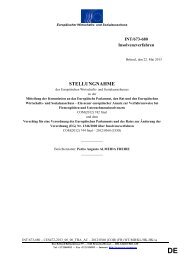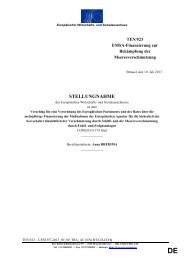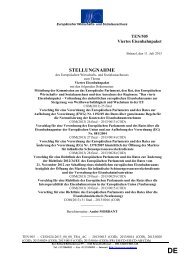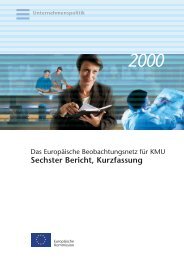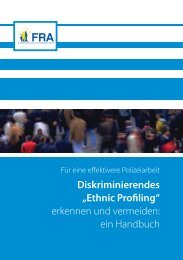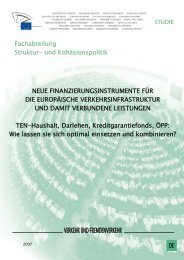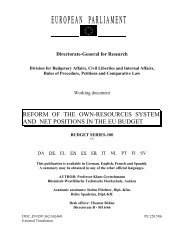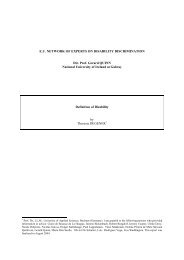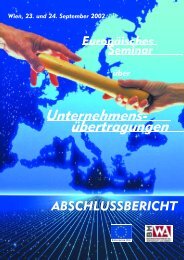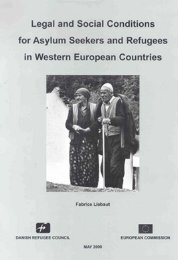final report of an audit carried out in namibia from 19 february to 01 ...
final report of an audit carried out in namibia from 19 february to 01 ...
final report of an audit carried out in namibia from 19 february to 01 ...
You also want an ePaper? Increase the reach of your titles
YUMPU automatically turns print PDFs into web optimized ePapers that Google loves.
Ref. Ares(2<strong>01</strong>3)2555173 - 02/07/2<strong>01</strong>3<br />
EUROPEAN COMMISSION<br />
HEALTH AND CONSUMERS DIRECTORATE-GENERAL<br />
Direc<strong>to</strong>rate F - Food <strong>an</strong>d Veter<strong>in</strong>ary Office<br />
DG(SANCO) 2<strong>01</strong>3-6774 - MR FINAL<br />
FINAL REPORT OF AN AUDIT<br />
CARRIED OUT IN<br />
NAMIBIA<br />
FROM <strong>19</strong> FEBRUARY TO <strong>01</strong> MARCH 2<strong>01</strong>3<br />
IN ORDER TO EVALUATE THE OPERATION OF CONTROLS OVER THE PRODUCTION OF<br />
FRESH BOVINE AND OVINE MEAT, FARMED AND WILD GAME MEAT DESTINED FOR<br />
EXPORT TO THE EUROPEAN UNION, AS WELL AS CERTIFICATION PROCEDURES
Executive Summary<br />
The <strong>report</strong> describes the <strong>out</strong>come <strong>of</strong> <strong>an</strong> <strong>audit</strong> <strong>carried</strong> <strong>out</strong> by the Food <strong>an</strong>d Veter<strong>in</strong>ary Office (FVO)<br />
<strong>in</strong> Namibia <strong>from</strong> <strong>19</strong> February <strong>to</strong> 1 March 2<strong>01</strong>3. The objectives <strong>of</strong> the <strong>audit</strong> were <strong>to</strong> evaluate the<br />
<strong>of</strong>ficial public health controls <strong>in</strong> place for the export <strong>of</strong> fresh bov<strong>in</strong>e, ov<strong>in</strong>e <strong>an</strong>d farmed <strong>an</strong>d wild<br />
game meat for hum<strong>an</strong> consumption dest<strong>in</strong>ed for export <strong>to</strong> the Europe<strong>an</strong> Union (EU), as well as<br />
certification procedures <strong>an</strong>d the measures taken by the Namibi<strong>an</strong> authorities <strong>to</strong> address the<br />
deficiencies, the conclusions <strong>an</strong>d recommendations <strong>of</strong> previous FVO <strong>audit</strong> <strong>report</strong>s, <strong>in</strong> particular<br />
<strong>report</strong> DG(SANCO)/2<strong>01</strong>1-6120 (hereafter previous <strong>report</strong> 2<strong>01</strong>1-6120). The action pl<strong>an</strong> received<br />
<strong>from</strong> the Namibi<strong>an</strong> authorities provided satisfac<strong>to</strong>ry guar<strong>an</strong>tees <strong>in</strong> response <strong>to</strong> all six but one<br />
recommendation <strong>of</strong> the previous <strong>report</strong> 2<strong>01</strong>1-6120. This <strong>audit</strong> was comb<strong>in</strong>ed with <strong>audit</strong><br />
DG(SANCO)/2<strong>01</strong>3-6782, which reviewed the <strong>an</strong>imal health controls.<br />
The Direc<strong>to</strong>rate <strong>of</strong> Veter<strong>in</strong>ary Service (the DVS) has made huge efforts <strong>to</strong> adapt the <strong>an</strong>imal<br />
identification <strong>an</strong>d registration system <strong>in</strong> order <strong>to</strong> guar<strong>an</strong>tee the 90 day residence period <strong>in</strong> the EU<br />
approved zone <strong>an</strong>d the 40 day residence period at the last hold<strong>in</strong>g before <strong>an</strong>imals are sent for<br />
slaughter. Consequently, guar<strong>an</strong>tees could now be provided <strong>to</strong> meet the certification residency<br />
requirements for bov<strong>in</strong>e <strong>an</strong>d ov<strong>in</strong>e meat. A number <strong>of</strong> discrep<strong>an</strong>cies between the registration <strong>of</strong><br />
<strong>an</strong>imals <strong>in</strong> the Namibi<strong>an</strong> Lives<strong>to</strong>ck Identification Traceability System (NamLITS) compared with<br />
the actual number <strong>of</strong> <strong>an</strong>imals present at lives<strong>to</strong>ck hold<strong>in</strong>gs, or those who died or were slaughtered<br />
as well as some <strong>in</strong>efficiencies <strong>in</strong> <strong>of</strong>ficial controls on the registration <strong>of</strong> cattle <strong>an</strong>d movement<br />
controls weaken the reliability <strong>of</strong> the system.<br />
The DVS did not ensure that records <strong>of</strong> veter<strong>in</strong>ary medic<strong>in</strong>e treatments are kept at all hold<strong>in</strong>gs.<br />
The production <strong>of</strong> fresh bov<strong>in</strong>e, ov<strong>in</strong>e <strong>an</strong>d wild game meat is, <strong>in</strong> general, <strong>in</strong> compli<strong>an</strong>ce with the<br />
public health attestations laid down <strong>in</strong> the correspond<strong>in</strong>g model certificates for export <strong>to</strong> the EU.<br />
The DVS rema<strong>in</strong>s weak <strong>in</strong> their evaluation <strong>of</strong> systems based on Hazard Analysis Critical Control<br />
Po<strong>in</strong>t (HACCP) pr<strong>in</strong>ciples <strong>an</strong>d microbiological criteria for foodstuffs as well as the follow-up <strong>of</strong><br />
non-compli<strong>an</strong>t microbiological test results. The situation <strong>in</strong> one establishment, <strong>in</strong> particular, is<br />
worry<strong>in</strong>g, as the test results for carcass sampl<strong>in</strong>g are regularly positive for Salmonella with<strong>out</strong><br />
adequate corrective actions be<strong>in</strong>g taken by the food bus<strong>in</strong>ess opera<strong>to</strong>r (FBO) or the DVS. The<br />
DVS did not take corrective measures for this establishment even though it had recently concluded<br />
that the FBO did not have control over its food safety system.<br />
A number <strong>of</strong> recommendations have been made <strong>to</strong> the Competent Authority (CA) with a view <strong>to</strong><br />
address<strong>in</strong>g the deficiencies identified dur<strong>in</strong>g this <strong>audit</strong>.<br />
I
Table <strong>of</strong> Contents<br />
1 INTRODUCTION........................................................................................................................1<br />
2 OBJECTIVES............................................................................................................................1<br />
3 LEGAL BASIS..........................................................................................................................2<br />
4 BACKGROUND..........................................................................................................................2<br />
4.1 EXPORT STATISTICS........................................................................................................................2<br />
5 FINDINGS AND CONCLUSIONS...................................................................................................3<br />
5.1 LEGISLATION AND COMPETENT AUTHORITIES.....................................................................................3<br />
5.1.1 LEGAL BASIS..........................................................................................................................3<br />
5.1.2 FINDINGS.............................................................................................................................3<br />
5.1.3 CONCLUSIONS........................................................................................................................5<br />
5.2 HOLDING REGISTRATION, ANIMAL IDENTIFICATION...............................................................................5<br />
5.2.1 LEGAL REQUIREMENTS............................................................................................................5<br />
5.2.2 FINDINGS.............................................................................................................................6<br />
5.2.3 CONCLUSIONS........................................................................................................................8<br />
5.3 LABORATORY SERVICES...................................................................................................................8<br />
5.3.1 LEGAL REQUIREMENTS............................................................................................................8<br />
5.3.2 FINDINGS.............................................................................................................................8<br />
5.3.3 CONCLUSIONS........................................................................................................................8<br />
5.4 LISTING OF ESTABLISHMENTS...........................................................................................................9<br />
5.4.1 LEGAL REQUIREMENTS.............................................................................................................9<br />
5.4.2 FINDINGS.............................................................................................................................9<br />
5.4.3 CONCLUSIONS........................................................................................................................9<br />
5.5 OFFICIAL CONTROLS AT ESTABLISHMENT LEVEL...................................................................................9<br />
5.5.1 LEGAL REQUIREMENTS.............................................................................................................9<br />
5.5.2 FINDINGS...........................................................................................................................10<br />
5.5.3 CONCLUSIONS......................................................................................................................13<br />
5.6 OFFICIAL CERTIFICATION...............................................................................................................13<br />
5.6.1 LEGAL REQUIREMENTS...........................................................................................................13<br />
5.6.2 CONCLUSIONS......................................................................................................................14<br />
6 OVERALL CONCLUSION..........................................................................................................14<br />
7 CLOSING MEETING................................................................................................................14<br />
8 RECOMMENDATIONS...............................................................................................................14<br />
ANNEX 1 - LEGAL REFERENCES.................................................................................................16<br />
II
ABBREVIATIONS AND DEFINITIONS USED IN THIS REPORT<br />
Abbreviation<br />
CA(s)<br />
CCA(s)<br />
DG(SANCO)<br />
DVS<br />
EC<br />
EU<br />
FBO(s)<br />
FVO<br />
HACCP<br />
NamLITS<br />
RFID<br />
Expl<strong>an</strong>ation<br />
Competent Authority(ies)<br />
Central Competent Authority(ies)<br />
Health & Consumers Direc<strong>to</strong>rate General<br />
The Direc<strong>to</strong>rate <strong>of</strong> Veter<strong>in</strong>ary Service<br />
Europe<strong>an</strong> Community(ies)<br />
Europe<strong>an</strong> Union<br />
Food Bus<strong>in</strong>ess Opera<strong>to</strong>r(s)<br />
Food <strong>an</strong>d Veter<strong>in</strong>ary Office<br />
Hazard Analysis <strong>of</strong> Critical Control Po<strong>in</strong>ts<br />
The Namibi<strong>an</strong> Lives<strong>to</strong>ck Identification Traceability System<br />
Radio-Frequency Identification<br />
III
1<br />
INTRODUCTION<br />
The <strong>audit</strong> <strong>to</strong>ok place <strong>in</strong> Namibia <strong>from</strong> <strong>19</strong> February <strong>to</strong> 1 March 2<strong>01</strong>3 as part <strong>of</strong> the pl<strong>an</strong>ned <strong>audit</strong><br />
programme <strong>of</strong> the FVO. The <strong>audit</strong> team comprised 2 <strong>in</strong>spec<strong>to</strong>rs <strong>from</strong> the FVO. This <strong>audit</strong> was<br />
comb<strong>in</strong>ed with <strong>audit</strong> DG(SANCO)2<strong>01</strong>3-6782, which reviewed the <strong>an</strong>imal health controls.<br />
The FVO <strong>audit</strong> team was accomp<strong>an</strong>ied by representatives <strong>from</strong> the Central Competent Authority<br />
(CCA), the DVS.<br />
The open<strong>in</strong>g meet<strong>in</strong>g was held on <strong>19</strong> February 2<strong>01</strong>3 with the DVS <strong>in</strong> W<strong>in</strong>dhoek. At this meet<strong>in</strong>g the<br />
<strong>audit</strong> team confirmed the objectives <strong>of</strong>, <strong>an</strong>d it<strong>in</strong>erary for the <strong>audit</strong>, <strong>an</strong>d additional <strong>in</strong>formation<br />
required for the satisfac<strong>to</strong>ry completion <strong>of</strong> the <strong>audit</strong> was requested.<br />
2 OBJECTIVES<br />
The objectives <strong>of</strong> the <strong>audit</strong> were <strong>to</strong> evaluate the <strong>of</strong>ficial public health controls <strong>in</strong> place for the export<br />
<strong>of</strong> fresh meat as well as the measures taken by the Namibi<strong>an</strong> authorities <strong>to</strong> address the deficiencies,<br />
the conclusions <strong>an</strong>d recommendations <strong>of</strong> previous FVO <strong>audit</strong> <strong>report</strong>s, <strong>in</strong> particular <strong>report</strong><br />
DG(SANCO)/2<strong>01</strong>1-6120.<br />
The scope <strong>of</strong> the <strong>audit</strong> covered the <strong>of</strong>ficial controls <strong>an</strong>d certification <strong>of</strong> fresh bov<strong>in</strong>e, ov<strong>in</strong>e meat,<br />
farmed <strong>an</strong>d wild game meat <strong>in</strong>tended for export <strong>to</strong> the EU.<br />
The <strong>audit</strong> team <strong>in</strong> particular:<br />
• reviewed the systems for certification <strong>of</strong> <strong>an</strong>imals <strong>an</strong>d meat <strong>in</strong> relation <strong>to</strong> the requirements <strong>of</strong><br />
Council Directive 96/93/EC;<br />
• reviewed the system for the control <strong>an</strong>d record<strong>in</strong>g <strong>of</strong> <strong>an</strong>imal movements, <strong>in</strong>clud<strong>in</strong>g those<br />
controls necessary for certification <strong>in</strong> accord<strong>an</strong>ce with the requirements <strong>of</strong> Commission<br />
Regulation (EU) No 206/2<strong>01</strong>0;<br />
• assessed the controls <strong>in</strong> place over the production <strong>of</strong> fresh meat, <strong>in</strong> particular bov<strong>in</strong>e, ov<strong>in</strong>e,<br />
farmed <strong>an</strong>d wild game meat, <strong>in</strong>clud<strong>in</strong>g those controls necessary for certification <strong>in</strong><br />
accord<strong>an</strong>ce with the requirements <strong>of</strong> Commission Regulation (EU) No 206/2<strong>01</strong>0.<br />
In particular, controls over bov<strong>in</strong>e <strong>an</strong>d ov<strong>in</strong>e meat <strong>an</strong>d farmed <strong>an</strong>d wild game meat <strong>in</strong> the<br />
framework <strong>of</strong> Regulations (EC) No 178/2002, No 852/2004, No 853/2004, No 854/2004 <strong>an</strong>d No<br />
882/2004 as well as Council Directive 97/78/EC were subject <strong>to</strong> this evaluation. In pursuit <strong>of</strong> these<br />
objectives, the <strong>audit</strong> it<strong>in</strong>erary <strong>in</strong>cluded the follow<strong>in</strong>g:<br />
COMPETENT AUTHORITIES<br />
Competent<br />
Authorities<br />
Central<br />
Regional<br />
Local<br />
Comments<br />
Open<strong>in</strong>g <strong>an</strong>d clos<strong>in</strong>g meet<strong>in</strong>gs, meet<strong>in</strong>g at district<br />
veter<strong>in</strong>ary <strong>of</strong>fices <strong>an</strong>d <strong>in</strong>terviews with local <strong>of</strong>ficial<br />
staff at establishments visited<br />
FOOD PRODUCTION / PROCESSING / DISTRIBUTION – ACTIVITIES<br />
Slaughterhouses 4<br />
1
COMPETENT AUTHORITIES<br />
Comments<br />
Cutt<strong>in</strong>g premises 5 One <strong>in</strong>dependent cutt<strong>in</strong>g pl<strong>an</strong>t<br />
Game h<strong>an</strong>dl<strong>in</strong>g establishments 2<br />
Cold s<strong>to</strong>res 1 One <strong>in</strong>dependent cold s<strong>to</strong>re<br />
Labora<strong>to</strong>ries 1<br />
Assembly centres 2 Auctions<br />
Lives<strong>to</strong>ck hold<strong>in</strong>gs 4 One feedlot, one sheep <strong>an</strong>d two cattle hold<strong>in</strong>gs<br />
Field abat<strong>to</strong>ir 1<br />
3 LEGAL BASIS<br />
The <strong>audit</strong> was <strong>carried</strong> <strong>out</strong> under the general provisions <strong>of</strong> EU legislation <strong>an</strong>d, <strong>in</strong> particular Article 46<br />
<strong>of</strong> Regulation (EC) No 882/2004 <strong>of</strong> the Europe<strong>an</strong> Parliament <strong>an</strong>d <strong>of</strong> the Council on <strong>of</strong>ficial controls<br />
performed <strong>to</strong> ensure the verification <strong>of</strong> compli<strong>an</strong>ce with feed <strong>an</strong>d food law, <strong>an</strong>imal health <strong>an</strong>d<br />
<strong>an</strong>imal welfare rules.<br />
N.B. Full legal references are provided <strong>in</strong> Annex 1. Legal acts quoted <strong>in</strong> this <strong>report</strong> refer, where<br />
applicable, <strong>to</strong> the latest amended version.<br />
4 BACKGROUND<br />
The previous <strong>audit</strong> concern<strong>in</strong>g safety <strong>of</strong> food <strong>of</strong> <strong>an</strong>imal orig<strong>in</strong> <strong>in</strong> Namibia was <strong>carried</strong> <strong>out</strong> <strong>from</strong> 31<br />
J<strong>an</strong>uary <strong>to</strong> 8 February 2<strong>01</strong>1. The results are described <strong>in</strong> the <strong>report</strong> 2<strong>01</strong>1-6120. This <strong>report</strong> is<br />
accessible on the Health <strong>an</strong>d Consumers Direc<strong>to</strong>rate General DG(SANCO) website:<br />
http://ec.europa.eu/food/fvo/ir_search_en.cfm<br />
The action pl<strong>an</strong> received <strong>from</strong> the Namibi<strong>an</strong> authorities provided satisfac<strong>to</strong>ry guar<strong>an</strong>tees <strong>in</strong> response<br />
<strong>to</strong> all six but one recommendations <strong>of</strong> the previous <strong>report</strong> 2<strong>01</strong>1-6120. Recommendation one <strong>of</strong> the<br />
previous <strong>report</strong> 2<strong>01</strong>1-6120 was related <strong>to</strong> the 90 day residence requirements <strong>in</strong> the EU approved<br />
area NA-1 <strong>an</strong>d the 40 day residence period <strong>in</strong> the last hold<strong>in</strong>g before send<strong>in</strong>g for slaughter. At the<br />
open<strong>in</strong>g meet<strong>in</strong>g <strong>of</strong> this <strong>audit</strong>, the DVS provided <strong>an</strong> up-date on the guar<strong>an</strong>tees for all six<br />
recommendations. Four recommendations were followed up dur<strong>in</strong>g this <strong>audit</strong>.<br />
4.1 EXPORT STATISTICS<br />
The volumes (expressed <strong>in</strong> <strong>to</strong>nnes) <strong>of</strong> beef, ov<strong>in</strong>e <strong>an</strong>d wild game meat exported <strong>to</strong> the EU, Norway<br />
<strong>an</strong>d Switzerl<strong>an</strong>d <strong>in</strong> 2<strong>01</strong>1 <strong>an</strong>d 2<strong>01</strong>2 as provided by the DVS is given <strong>in</strong> the tables below. There is no<br />
trade between Namibia <strong>an</strong>d the EU <strong>in</strong> the fresh farmed game meat, goat meat <strong>an</strong>d m<strong>in</strong>ced meat<br />
sec<strong>to</strong>rs.<br />
2<strong>01</strong>1 EU Norway Switzerl<strong>an</strong>d<br />
Bov<strong>in</strong>e meat 9 924 1 413 21<br />
Ov<strong>in</strong>e meat - 26.4 -<br />
Wild game 44.9 - -<br />
2
2<strong>01</strong>2 EU Norway Switzerl<strong>an</strong>d<br />
Bov<strong>in</strong>e meat 9 333 1 565 21<br />
Ov<strong>in</strong>e meat 41 81 -<br />
Wild game 110 - -<br />
5 FINDINGS AND CONCLUSIONS<br />
5.1 LEGISLATION AND COMPETENT AUTHORITIES<br />
5.1.1 Legal basis<br />
Article 46.1 <strong>of</strong> Regulation (EC) No 882/2004 stipulates that <strong>of</strong>ficial controls by Commission<br />
experts <strong>in</strong> third countries shall verify compli<strong>an</strong>ce or equivalence <strong>of</strong> third country legislation <strong>an</strong>d<br />
systems with EU feed <strong>an</strong>d food law, <strong>an</strong>d EU <strong>an</strong>imal health legislation. These controls shall have<br />
particular regard <strong>to</strong> po<strong>in</strong>ts (a) <strong>to</strong> (e) <strong>an</strong>d (g) <strong>of</strong> the aforementioned Article.<br />
5.1.2 F<strong>in</strong>d<strong>in</strong>gs<br />
5.1.2.1 Competent Authorities<br />
5.1.2.1.1 Org<strong>an</strong>isation <strong>of</strong> Competent Authorities<br />
The DVS stated that the org<strong>an</strong>isation <strong>of</strong> the CAs, their powers, <strong>in</strong>dependence <strong>an</strong>d authority for<br />
enforcement rema<strong>in</strong>s as described <strong>in</strong> the previous <strong>report</strong> 2<strong>01</strong>1-6120.<br />
Observations:<br />
5.1.2.1.2 Supervision<br />
• The Public Health Division <strong>of</strong> the CCA <strong>carried</strong> <strong>out</strong> yearly supervisory <strong>audit</strong>s <strong>in</strong> the EU<br />
approved establishments. These CCA <strong>audit</strong>s were, as described <strong>in</strong> the previous <strong>report</strong> 2<strong>01</strong>1-<br />
6120 still focused on the FBO’s compli<strong>an</strong>ce with export requirements rather th<strong>an</strong> verify<strong>in</strong>g<br />
the effectiveness <strong>of</strong> <strong>of</strong>ficial controls <strong>to</strong> ensure that corrective actions are taken when needed<br />
<strong>an</strong>d that documented procedures are updated as appropriate.<br />
5.1.2.1.3 Tra<strong>in</strong><strong>in</strong>g <strong>of</strong> staff <strong>in</strong> perform<strong>an</strong>ce <strong>of</strong> <strong>of</strong>ficial controls<br />
The FVO <strong>audit</strong> team did not receive <strong>in</strong>formation <strong>from</strong> the DVS on updates s<strong>in</strong>ce the previous <strong>audit</strong><br />
2<strong>01</strong>1-6120. It has been identified by the FVO <strong>audit</strong> team that the <strong>of</strong>ficial veter<strong>in</strong>ari<strong>an</strong>s have<br />
<strong>in</strong>sufficient knowledge <strong>of</strong> the requirements on microbiological criteria for carcass sampl<strong>in</strong>g,<br />
<strong>in</strong>terpretation <strong>of</strong> test results <strong>an</strong>d corrective actions <strong>to</strong> be taken <strong>in</strong> the case <strong>of</strong> unfavourable test<br />
results <strong>an</strong>d that not all <strong>of</strong>ficial veter<strong>in</strong>ari<strong>an</strong>s supervis<strong>in</strong>g the EU approved establishments are<br />
familiar with the traceability systems <strong>in</strong> place.<br />
3
5.1.2.1.4<br />
Resources<br />
Observations:<br />
• The DVS <strong>in</strong>formed the FVO <strong>audit</strong> team that the number <strong>of</strong> staff had further <strong>in</strong>creased s<strong>in</strong>ce<br />
the previous <strong>audit</strong> 2<strong>01</strong>1-6120. The occup<strong>an</strong>cy rate is now more th<strong>an</strong> 90% <strong>of</strong> the established<br />
737 posts.<br />
• Although the DVS had <strong>an</strong>nounced dur<strong>in</strong>g the previous <strong>audit</strong> 2<strong>01</strong>1-6120 the recruitment <strong>of</strong><br />
new staff <strong>in</strong> order <strong>to</strong> achieve freedom <strong>of</strong> Foot <strong>an</strong>d M<strong>out</strong>h Disease <strong>an</strong>d Contageous Bov<strong>in</strong>e<br />
Pleuropneumonitis <strong>in</strong> the Northern Communal areas, the project did not start <strong>an</strong>d no <strong>in</strong>crease<br />
<strong>in</strong> staff <strong>to</strong>ok place. The DVS still pl<strong>an</strong>s <strong>to</strong> start this project.<br />
• The FVO <strong>audit</strong> team did not see <strong>an</strong>y evidence <strong>of</strong> a shortage <strong>of</strong> staff at the DVS <strong>in</strong> the<br />
carry<strong>in</strong>g <strong>out</strong> <strong>of</strong> control activities, with the exception <strong>of</strong> one establishment visited. This has<br />
also been <strong>report</strong>ed <strong>in</strong> the previous <strong>report</strong> 2<strong>01</strong>1-6120. The only appo<strong>in</strong>ted <strong>of</strong>ficial veter<strong>in</strong>ari<strong>an</strong><br />
<strong>in</strong> the multi-activities establishment was only occasionally present for post-mortem<br />
<strong>in</strong>spections <strong>in</strong> the period June <strong>to</strong> Oc<strong>to</strong>ber 2<strong>01</strong>2.<br />
• The DVS stated that the frequency <strong>of</strong> <strong>an</strong>nual on-farm <strong>in</strong>spections <strong>in</strong> one district visited,<br />
could not be met due <strong>to</strong> a lack <strong>of</strong> staff.<br />
5.1.2.1.5 Org<strong>an</strong>isation <strong>of</strong> control systems<br />
In response <strong>to</strong> recommendation two <strong>of</strong> the previous <strong>report</strong> 2<strong>01</strong>1-6120 “<strong>to</strong> ensure that the<br />
guar<strong>an</strong>tees for public health attestation set <strong>out</strong> <strong>in</strong> II.1.1. (HACCP pr<strong>in</strong>ciples), II.1.2 (specific<br />
hygiene conditions) <strong>an</strong>d II.1.6 (microbiological criteria for foodstuff) <strong>of</strong> the model certificates<br />
“BOV”, “OVI” <strong>an</strong>d “RUW” as laid down <strong>in</strong> Regulation (EU) No 206/2<strong>01</strong>0 are met <strong>an</strong>d adequate<br />
supervision takes place”, the DVS has reviewed by me<strong>an</strong>s <strong>of</strong> Circular V21/2<strong>01</strong>2, the risk based<br />
<strong>audit</strong> system <strong>in</strong> order <strong>to</strong> establish the frequency <strong>of</strong> <strong>in</strong>spection visits for the <strong>of</strong>ficial veter<strong>in</strong>ari<strong>an</strong> <strong>to</strong><br />
ensure that establishments approved for the export <strong>of</strong> meat <strong>to</strong> the EU comply with the relev<strong>an</strong>t EU<br />
requirements. The frequency <strong>of</strong> <strong>in</strong>spection visits by the <strong>of</strong>ficial veter<strong>in</strong>ari<strong>an</strong> may r<strong>an</strong>ge <strong>from</strong> two <strong>to</strong><br />
twelve month <strong>in</strong>tervals <strong>an</strong>d results <strong>from</strong> a rat<strong>in</strong>g level that is based on the CCA <strong>an</strong>nual verification<br />
<strong>audit</strong>.<br />
Observations:<br />
• Circular V21/2<strong>01</strong>2 conta<strong>in</strong>s confus<strong>in</strong>g <strong>in</strong>formation on the scope, the responsibilities for the<br />
<strong>of</strong>ficial veter<strong>in</strong>ari<strong>an</strong> <strong>an</strong>d also for the CCA. It refers <strong>to</strong> <strong>in</strong>correct EU legislation <strong>an</strong>d provides<br />
<strong>in</strong>complete guid<strong>an</strong>ce for controls on HACCP based pr<strong>in</strong>ciples <strong>an</strong>d approval <strong>of</strong><br />
establishments.<br />
• The check-list <strong>an</strong>nexed <strong>to</strong> this Circular V21/2<strong>01</strong>2 conta<strong>in</strong>s a number <strong>of</strong> questions for which<br />
it is unavoidable <strong>to</strong> respond <strong>to</strong> with<strong>out</strong> provid<strong>in</strong>g conflict<strong>in</strong>g responses. As a consequence,<br />
certa<strong>in</strong> questions were <strong>an</strong>swered with both a satisfac<strong>to</strong>ry <strong>an</strong>d a non-satisfac<strong>to</strong>ry response.<br />
• In one establishment visited, the set frequency <strong>of</strong> <strong>in</strong>spections by the CCA was not followed<br />
by the <strong>of</strong>ficial veter<strong>in</strong>ari<strong>an</strong>. In addition, although not authorised <strong>to</strong> do, the frequency <strong>of</strong><br />
<strong>in</strong>spection visits was reduced by the <strong>of</strong>ficial veter<strong>in</strong>ari<strong>an</strong> based on the <strong>in</strong>spection results.<br />
4
• The CCA stated that <strong>audit</strong>s on certification <strong>of</strong> EU eligible meat <strong>to</strong>ok place, but no such<br />
evidence has been provided.<br />
5.1.2.1.6 Documented control procedures<br />
Documented procedures are <strong>in</strong> place <strong>an</strong>d are described <strong>in</strong> the previous <strong>report</strong> 2<strong>01</strong>1-6120.<br />
In response <strong>to</strong> recommendations one <strong>an</strong>d two <strong>of</strong> the previous <strong>report</strong> 2<strong>01</strong>1-6120, the DVS <strong>in</strong>formed<br />
the FVO <strong>audit</strong> team that documented procedures had been reviewed; <strong>in</strong> particular those controls<br />
related <strong>to</strong> the residency period <strong>of</strong> EU eligible <strong>an</strong>imals, the HACCP based pr<strong>in</strong>ciples <strong>an</strong>d the<br />
<strong>in</strong>spection frequency for the <strong>of</strong>ficial veter<strong>in</strong>ari<strong>an</strong>.<br />
Observations:<br />
• The documented procedures for <strong>of</strong>ficial controls related <strong>to</strong> HACCP based pr<strong>in</strong>ciples<br />
conta<strong>in</strong>ed both confus<strong>in</strong>g <strong>an</strong>d <strong>in</strong>correct <strong>in</strong>formation. In addition the check-list does not<br />
foresee controls on the relev<strong>an</strong>t criteria for microbiological sampl<strong>in</strong>g <strong>of</strong> carcasses.<br />
• The circular V16/2007 regard<strong>in</strong>g controls on microbiological criteria for foodstuff was not<br />
followed by the <strong>of</strong>ficial veter<strong>in</strong>ari<strong>an</strong>s <strong>in</strong> the establishments visited, <strong>in</strong> particular, the<br />
requirement for the <strong>of</strong>ficial <strong>to</strong> verify FBOs' compli<strong>an</strong>ces with process hygiene criteria,<br />
FBOs' written procedures on sampl<strong>in</strong>g, sample collection, receiv<strong>in</strong>g <strong>an</strong>d record<strong>in</strong>g <strong>of</strong> test<br />
results <strong>an</strong>d corrective actions <strong>in</strong> case <strong>of</strong> deviations.<br />
• The DVS staff at lives<strong>to</strong>ck hold<strong>in</strong>gs must check 80% <strong>of</strong> the <strong>an</strong>imals for <strong>an</strong>imal<br />
identification. However, the <strong>in</strong>spection <strong>in</strong>struction does not lay down the requirements <strong>to</strong><br />
cross-check between <strong>an</strong>imals' identification <strong>an</strong>d their registration <strong>in</strong> the NamLITS with the<br />
number <strong>of</strong> <strong>an</strong>imals registered <strong>an</strong>d the read<strong>in</strong>g <strong>of</strong> their <strong>in</strong>dividual identification.<br />
• No documented procedures are established <strong>to</strong> verify the number <strong>of</strong> <strong>an</strong>imals arriv<strong>in</strong>g at the<br />
slaughterhouses <strong>an</strong>d their <strong>in</strong>dividual (cattle) or group (sheep) identification as well as action<br />
<strong>to</strong> be taken <strong>in</strong> case <strong>of</strong> non-compli<strong>an</strong>ces, for example <strong>in</strong> case the 90 day residence period is<br />
not met.<br />
• A special <strong>in</strong>struction has been established for <strong>of</strong>ficial controls at the feedlot. The check-list<br />
covered controls over feed <strong>an</strong>d feed<strong>in</strong>g practices, veter<strong>in</strong>ary medic<strong>in</strong>e treatment, disease<br />
occurrence <strong>an</strong>d prevention, cattle h<strong>an</strong>dl<strong>in</strong>g facilities, traceability <strong>an</strong>d <strong>an</strong>imal welfare.<br />
5.1.3 Conclusions<br />
The control system <strong>in</strong> Namibia has the potential <strong>to</strong> provide satisfac<strong>to</strong>ry assur<strong>an</strong>ces regard<strong>in</strong>g<br />
compli<strong>an</strong>ce with, or equivalence <strong>to</strong>, EU requirements.<br />
5.2 HOLDING REGISTRATION, ANIMAL IDENTIFICATION<br />
5.2.1 Legal Requirements<br />
The veter<strong>in</strong>ary certification requirements for the <strong>in</strong>troduction <strong>in</strong><strong>to</strong> the EU <strong>of</strong> fresh meat are laid<br />
down <strong>in</strong> Regulation (EU) No 206/2<strong>01</strong>0. Po<strong>in</strong>t II.2 <strong>of</strong> the model certificates, <strong>in</strong> Part 2 <strong>of</strong> Annex II <strong>to</strong><br />
the Regulation, sets <strong>out</strong> the requirements for <strong>an</strong>imal health conditions <strong>an</strong>d for traceability <strong>of</strong> bov<strong>in</strong>e<br />
5
<strong>an</strong>imals (with the effect that the CA must have <strong>in</strong> place a system for hold<strong>in</strong>g registration, <strong>an</strong>imal<br />
identification <strong>an</strong>d movement control <strong>an</strong>d record<strong>in</strong>g).<br />
5.2.2 F<strong>in</strong>d<strong>in</strong>gs<br />
5.2.2.1 Hold<strong>in</strong>g registration<br />
The system <strong>of</strong> hold<strong>in</strong>g registration rema<strong>in</strong>s as described <strong>in</strong> the previous <strong>report</strong> 2<strong>01</strong>1-6120.<br />
5.2.2.2 Animal identification <strong>an</strong>d registration system, movement controls<br />
In response <strong>to</strong> recommendation one <strong>of</strong> the previous <strong>report</strong> 2<strong>01</strong>1-6120 “<strong>to</strong> guar<strong>an</strong>tee the 90 day<br />
residency <strong>in</strong> the EU approved zone NA-1 <strong>an</strong>d 40 day residency on the last hold<strong>in</strong>g before be<strong>in</strong>g sent<br />
for slaughter”, the DVS <strong>in</strong>formed the FVO <strong>audit</strong> team that all EU eligible cattle are <strong>in</strong>dividually<br />
identified <strong>an</strong>d registered <strong>in</strong> the NamLITS database. The deadl<strong>in</strong>e for implementation <strong>of</strong> the new<br />
<strong>an</strong>imal identification <strong>an</strong>d registration system was 2 August 2<strong>01</strong>1. S<strong>in</strong>ce this date cattle are<br />
<strong>in</strong>dividually identified with double yellow ear tags by the age <strong>of</strong> six months or younger when calves<br />
need <strong>to</strong> be moved. The <strong>in</strong>dividual identification number is composed <strong>of</strong> eight digits on one visual<br />
tag <strong>an</strong>d one Radio-Frequency Identification tag (RFID - primary tag). If the primary tag is lost, both<br />
tags must be replaced with a new tag l<strong>in</strong>ked <strong>to</strong> the old number. If the secondary tag is lost, the tag<br />
c<strong>an</strong> be simply replaced with a pr<strong>in</strong>ted tag or a bl<strong>an</strong>k tag us<strong>in</strong>g <strong>in</strong>delible marker pen. The secondary<br />
tag must not be replaced if cattle are sent for slaughter or exported. There is no obligation for the<br />
owner <strong>to</strong> record replacement tags <strong>in</strong> the herd register. The system <strong>to</strong> identify ownership by me<strong>an</strong>s <strong>of</strong><br />
s<strong>to</strong>ck br<strong>an</strong>d<strong>in</strong>g rema<strong>in</strong>s <strong>in</strong> place.<br />
The identification system for sheep rema<strong>in</strong>s as described <strong>in</strong> the previous <strong>report</strong> 2<strong>01</strong>1-6120.<br />
The movement permits, which are issued at the State Veter<strong>in</strong>ary Offices conta<strong>in</strong> a declaration <strong>to</strong> be<br />
completed by the owner at the moment <strong>of</strong> load<strong>in</strong>g. This declaration <strong>in</strong>cludes a statement on the<br />
<strong>an</strong>imals' 90/40 day residency period <strong>an</strong>d <strong>an</strong> <strong>an</strong>nex with all recorded <strong>in</strong>dividual identification<br />
numbers.<br />
The owner must notify the NamLITS with<strong>in</strong> 14 days <strong>of</strong> registration <strong>of</strong> the cattle/sheep <strong>an</strong>d with<strong>in</strong> 7<br />
days <strong>of</strong> arrival by provid<strong>in</strong>g the orig<strong>in</strong>al movement permit. If a permit is not used, the owner has <strong>to</strong><br />
declare this <strong>to</strong> the NamLITS. The DVS updates the NamLITS, which is for 2 <strong>out</strong> <strong>of</strong> <strong>19</strong> district<br />
<strong>of</strong>fices delegated <strong>to</strong> <strong>an</strong> agency. If a movement permit is not notified with<strong>in</strong> 7 days, the NamLITS<br />
will au<strong>to</strong>matically restrict the movements <strong>from</strong> both, the arrival <strong>an</strong>d departure hold<strong>in</strong>g until<br />
notification is received.<br />
The NamLITS has been further developed s<strong>in</strong>ce the previous <strong>audit</strong> 2<strong>01</strong>1-6120 allow<strong>in</strong>g the DVS <strong>to</strong><br />
verify the 90/40 day residency periods. This verification function is also made available <strong>to</strong><br />
slaughterhouse staff, auctioneers <strong>an</strong>d owners for their own cattle.<br />
Opera<strong>to</strong>rs <strong>of</strong> slaughterhouses, auctioneers <strong>an</strong>d some owners <strong>of</strong> bov<strong>in</strong>e <strong>an</strong>imals <strong>in</strong>vested <strong>in</strong> readers<br />
<strong>an</strong>d the <strong>in</strong>formation ab<strong>out</strong> the arrival, slaughter data <strong>an</strong>d departure is sent electronically <strong>to</strong> the<br />
NamLITS.<br />
The NamLITS is able <strong>to</strong> provide the movement his<strong>to</strong>ry <strong>of</strong> <strong>in</strong>dividual bov<strong>in</strong>e <strong>an</strong>imals once identified<br />
<strong>an</strong>d registered.<br />
6
In response <strong>to</strong> recommendation five <strong>of</strong> the previous <strong>report</strong> 2<strong>01</strong>1-6120 “<strong>to</strong> guar<strong>an</strong>tee that records<br />
are kept <strong>of</strong> treatments with all veter<strong>in</strong>ary medic<strong>in</strong>al products, for all food produc<strong>in</strong>g species”, the<br />
DVS guar<strong>an</strong>teed that records <strong>of</strong> treatments with all veter<strong>in</strong>ary medic<strong>in</strong>al products are kept <strong>an</strong>d <strong>to</strong> be<br />
specifically checked dur<strong>in</strong>g farm <strong>in</strong>spections.<br />
Observations<br />
• At one auction visited, the auctioneer stated that only EU eligible <strong>an</strong>imals passed through<br />
the auction. This was not the case when verified aga<strong>in</strong>st the NamLITS (some <strong>an</strong>imals were<br />
not registered as be<strong>in</strong>g present for 90 days <strong>in</strong> the EU approved area).<br />
• At this auction, <strong>out</strong> <strong>of</strong> 80 movement permits verified, seven were not completed by the<br />
owner regard<strong>in</strong>g the 40 day residence period <strong>an</strong>d for two <strong>in</strong> addition <strong>in</strong>formation was also<br />
miss<strong>in</strong>g on the 90 day residence period or residency s<strong>in</strong>ce birth <strong>in</strong> the EU approved zone.<br />
• At a second auction visited, there were discrep<strong>an</strong>cies <strong>in</strong> the number <strong>of</strong> <strong>an</strong>imals which left<br />
<strong>an</strong>d arrived at the auction. More <strong>an</strong>imals had left th<strong>an</strong> had arrived <strong>an</strong>d the records <strong>of</strong> the<br />
auction did not match the data available at the State Veter<strong>in</strong>ary Office. The DVS did not<br />
identify this non-compli<strong>an</strong>ce <strong>in</strong> the reconciliation <strong>of</strong> movements.<br />
• At both auctions visited, <strong>an</strong>imals with<strong>out</strong> a primary tag were separated <strong>an</strong>d were sent back <strong>to</strong><br />
the hold<strong>in</strong>g <strong>of</strong> orig<strong>in</strong>.<br />
• In the feedlot visited, the FVO <strong>audit</strong> team identified one <strong>an</strong>imal with two primary <strong>an</strong>d one<br />
secondary tag. The identification number <strong>of</strong> the secondary <strong>an</strong>d one primary tag matched, but<br />
this number was allocated for <strong>an</strong> <strong>an</strong>imal that was present at the farm <strong>of</strong> orig<strong>in</strong>. The other<br />
primary tag was registered for <strong>an</strong> <strong>an</strong>imal present at the feedlot that had been moved <strong>from</strong> the<br />
same farm.<br />
• At one hold<strong>in</strong>g visited, the owner did not declare for several years all deaths <strong>to</strong> the<br />
NamLITS although deaths are recorded <strong>in</strong> the hold<strong>in</strong>g register.<br />
• At two slaughterhouses visited, <strong>an</strong>imals with<strong>out</strong> primary tags are accepted for slaughter by<br />
the FBO with<strong>out</strong> <strong>in</strong>form<strong>in</strong>g the <strong>of</strong>ficial veter<strong>in</strong>ari<strong>an</strong>. These <strong>an</strong>imals are declassified by the<br />
FBO as non-EU eligible.<br />
• At slaughterhouses, the <strong>of</strong>ficial veter<strong>in</strong>ari<strong>an</strong> does not verify the <strong>to</strong>tal number <strong>of</strong> <strong>an</strong>imals on<br />
arrival <strong>an</strong>d their identification.<br />
• The FBOs at slaughterhouses downgrade systematically <strong>an</strong>imals not compli<strong>an</strong>t with the 90<br />
<strong>an</strong>d 40 day residency periods. The <strong>of</strong>ficial veter<strong>in</strong>ari<strong>an</strong> does not <strong>in</strong>vestigate non-compli<strong>an</strong>t<br />
<strong>an</strong>imals, <strong>in</strong> particular those that are not registered as be<strong>in</strong>g present for 90 days <strong>in</strong> the EU<br />
approved zone.<br />
• For some <strong>an</strong>imals examples were seen <strong>in</strong> the NamLITS <strong>of</strong> discrep<strong>an</strong>cies between the<br />
recorded slaughter date <strong>an</strong>d the recorded time <strong>of</strong> death e.g. One <strong>an</strong>imal was slaughtered on 7<br />
December 2<strong>01</strong>2 <strong>an</strong>d time <strong>of</strong> death was recorded as 10 J<strong>an</strong>uary 2<strong>01</strong>3.<br />
• Not all slaughterhouses <strong>an</strong>d auctions visited had direct access <strong>to</strong> the NamLITS.<br />
7
• At one hold<strong>in</strong>g visited, the owner did not keep records <strong>of</strong> veter<strong>in</strong>ary treatments other th<strong>an</strong><br />
the m<strong>an</strong>da<strong>to</strong>ry vacc<strong>in</strong>ation. At the feedlot visited, records <strong>of</strong> treatments with veter<strong>in</strong>ary<br />
medic<strong>in</strong>es were kept <strong>an</strong>d were subject <strong>to</strong> <strong>of</strong>ficial controls.<br />
5.2.3 Conclusions<br />
The DVS has made huge efforts <strong>to</strong> adapt the <strong>an</strong>imal identification <strong>an</strong>d registration system <strong>in</strong> order<br />
<strong>to</strong> guar<strong>an</strong>tee the 90 day residence period <strong>in</strong> the EU approved zone <strong>an</strong>d the 40 day residence period<br />
at the last hold<strong>in</strong>g before <strong>an</strong>imals are sent for slaughter. Consequently, guar<strong>an</strong>tees could now be<br />
provided <strong>to</strong> meet the certification residency requirements for bov<strong>in</strong>e <strong>an</strong>d ov<strong>in</strong>e meat.<br />
A number <strong>of</strong> discrep<strong>an</strong>cies between the registration <strong>of</strong> <strong>an</strong>imals <strong>in</strong> the NamLITS compared with the<br />
actual number <strong>of</strong> <strong>an</strong>imals present at lives<strong>to</strong>ck hold<strong>in</strong>gs, or those who died or were slaughtered as<br />
well as some <strong>in</strong>efficiencies <strong>in</strong> <strong>of</strong>ficial controls on the registration <strong>of</strong> cattle <strong>an</strong>d movement controls<br />
weaken the reliability <strong>of</strong> the system.<br />
The DVS did not ensure that records <strong>of</strong> veter<strong>in</strong>ary medic<strong>in</strong>e treatments are kept at all hold<strong>in</strong>gs.<br />
5.3 LABORATORY SERVICES<br />
5.3.1 Legal Requirements<br />
The veter<strong>in</strong>ary certification requirements for the <strong>in</strong>troduction <strong>in</strong><strong>to</strong> the EU <strong>of</strong> fresh meat are laid<br />
down <strong>in</strong> Regulation (EU) No 206/2<strong>01</strong>0. Po<strong>in</strong>t II.1 <strong>of</strong> the model certificates, <strong>in</strong> Part 2 <strong>of</strong> Annex II <strong>to</strong><br />
the Regulation, sets <strong>out</strong> the public health requirements <strong>to</strong> be met. These <strong>in</strong>clude the requirement <strong>to</strong><br />
satisfy the relev<strong>an</strong>t microbiological criteria set <strong>out</strong> <strong>in</strong> Regulation (EC) No 2073/2005 <strong>an</strong>d the special<br />
guar<strong>an</strong>tees concern<strong>in</strong>g Salmonella for consignments <strong>to</strong> F<strong>in</strong>l<strong>an</strong>d <strong>an</strong>d Sweden.<br />
5.3.2 F<strong>in</strong>d<strong>in</strong>gs<br />
The DVS <strong>in</strong>formed the FVO <strong>audit</strong> team that the Central Veter<strong>in</strong>ary Labora<strong>to</strong>ry is await<strong>in</strong>g the <strong>f<strong>in</strong>al</strong><br />
decision <strong>of</strong> the S<strong>out</strong>h Afric<strong>an</strong> Develop<strong>in</strong>g Countries Accreditation Services. As described <strong>in</strong> the<br />
previous <strong>report</strong> 2<strong>01</strong>1-6120, the Food Hygiene Section is <strong>in</strong>cluded <strong>in</strong> the scope <strong>of</strong> the accreditation<br />
for a few detection methods only. This Section is responsible for test<strong>in</strong>g meat samples <strong>an</strong>d<br />
environmental samples for microbiological criteria.<br />
Observations:<br />
Meat samples have been accepted for which the sample forms were not completed e.g. species. The<br />
test results for one slaughterhouse <strong>report</strong>ed <strong>in</strong> a few cases the results for bov<strong>in</strong>e meat (where the<br />
species was not def<strong>in</strong>ed on the sample form) whilst no cattle are be<strong>in</strong>g slaughtered <strong>in</strong> the<br />
slaughterhouse concerned.<br />
A few cases were noted by the FVO <strong>audit</strong> team for which samples were sent <strong>to</strong> the Central<br />
Veter<strong>in</strong>ary Labora<strong>to</strong>ry, but the results <strong>of</strong> tests did not arrive at the DVS or at the FBO. The DVS did<br />
not take <strong>an</strong>y action <strong>in</strong> order <strong>to</strong> obta<strong>in</strong> results.<br />
5.3.3 Conclusions<br />
The Central Veter<strong>in</strong>ary Labora<strong>to</strong>ry is await<strong>in</strong>g the <strong>f<strong>in</strong>al</strong> decision on its accreditation, which <strong>in</strong>cluded<br />
8
the section Food Hygiene for which the scope covers a few detection methods only. A few errors<br />
were identified <strong>in</strong> the <strong>report</strong><strong>in</strong>g <strong>of</strong> test results <strong>an</strong>d the h<strong>an</strong>dl<strong>in</strong>g <strong>of</strong> samples,which could have easily<br />
been avoided.<br />
5.4 LISTING OF ESTABLISHMENTS<br />
5.4.1 Legal requirements<br />
Article 12 <strong>of</strong> Regulation (EC) No 854/2004 requires that products <strong>of</strong> <strong>an</strong>imal orig<strong>in</strong> may be imported<br />
<strong>in</strong><strong>to</strong> the EU only if they have been dispatched <strong>from</strong>, <strong>an</strong>d obta<strong>in</strong>ed or prepared <strong>in</strong>, establishments that<br />
appear on lists drawn up, kept up-<strong>to</strong>-date <strong>an</strong>d communicated <strong>to</strong> the Commission.<br />
5.4.2 F<strong>in</strong>d<strong>in</strong>gs<br />
The FBOs <strong>of</strong> export approved establishments <strong>an</strong>nually receive <strong>from</strong> the CCA a renewal <strong>of</strong> their<br />
certificate confirm<strong>in</strong>g their compli<strong>an</strong>ce with the relev<strong>an</strong>t export market requirements, its activities<br />
<strong>an</strong>d species be<strong>in</strong>g processed.<br />
As <strong>report</strong>ed <strong>in</strong> the previous <strong>report</strong> 2<strong>01</strong>1-6120, the CCA could not provide evidence <strong>to</strong> the FVO <strong>audit</strong><br />
team, based on the follow-up <strong>of</strong> <strong>an</strong>nual <strong>audit</strong> <strong>report</strong>s, that they had concluded that the<br />
establishments were <strong>in</strong> compli<strong>an</strong>ce with the relev<strong>an</strong>t EU requirements.<br />
Observations:<br />
• For one cold s<strong>to</strong>re visited, the CA stated that a number <strong>of</strong> rooms are excluded <strong>from</strong> EU<br />
approval. No documented evidence is available. The exclusion <strong>of</strong> these rooms for EU<br />
eligible meat is also not reflected <strong>in</strong> the FBOs' procedures. The department concerned was<br />
not compli<strong>an</strong>t.<br />
• One recent <strong>audit</strong> <strong>report</strong> was seen, which concluded that the FBO <strong>of</strong> the slaughterhouse did<br />
not have control over its food safety system with<strong>out</strong> the CCA hav<strong>in</strong>g undertaken corrective<br />
measures with regard <strong>to</strong> the export <strong>of</strong> fresh meat <strong>to</strong> the EU. It concerned the establishment<br />
where the test results for carcass sampl<strong>in</strong>g are regularly positive for Salmonella (see po<strong>in</strong>t<br />
5.5.2.5 for details).<br />
5.4.3 Conclusions<br />
The list <strong>of</strong> establishments are kept up-<strong>to</strong>-date <strong>an</strong>d procedures are <strong>in</strong> place <strong>to</strong> verify the<br />
establishments' compli<strong>an</strong>ce with relev<strong>an</strong>t EU legislation. The DVS did not take corrective measures<br />
for one establishment for which it has recently concluded as not hav<strong>in</strong>g control over its food safety<br />
system.<br />
5.5 OFFICIAL CONTROLS AT ESTABLISHMENT LEVEL<br />
5.5.1 Legal requirements<br />
Article 12 <strong>of</strong> Regulation (EC) No 854/2004 lays down that the CA <strong>of</strong> a third country <strong>of</strong> orig<strong>in</strong> has <strong>to</strong><br />
guar<strong>an</strong>tee that establishments placed on the list <strong>of</strong> establishments <strong>from</strong> which imports <strong>of</strong> specified<br />
products <strong>of</strong> <strong>an</strong>imal orig<strong>in</strong> <strong>to</strong> the EU are permitted, <strong>to</strong>gether with <strong>an</strong>y establishments h<strong>an</strong>dl<strong>in</strong>g raw<br />
material <strong>of</strong> <strong>an</strong>imal orig<strong>in</strong> used <strong>in</strong> the m<strong>an</strong>ufacture <strong>of</strong> the products <strong>of</strong> <strong>an</strong>imal orig<strong>in</strong> concerned,<br />
9
complies with relev<strong>an</strong>t EU requirements, <strong>in</strong> particular those <strong>of</strong> Regulation (EC) No 853/2004, or<br />
with requirements that were determ<strong>in</strong>ed <strong>to</strong> be equivalent. It also lays down that <strong>an</strong> <strong>of</strong>ficial<br />
<strong>in</strong>spection service supervises the establishments <strong>an</strong>d has real powers <strong>to</strong> s<strong>to</strong>p the establishments <strong>from</strong><br />
export<strong>in</strong>g <strong>to</strong> the EU <strong>in</strong> the event that the establishments fail <strong>to</strong> meet the relev<strong>an</strong>t requirements.<br />
The <strong>an</strong>imal <strong>an</strong>d public health <strong>an</strong>d veter<strong>in</strong>ary certification requirements for the <strong>in</strong>troduction <strong>in</strong><strong>to</strong> the<br />
EU <strong>of</strong> products <strong>of</strong> <strong>an</strong>imal orig<strong>in</strong> <strong>in</strong>tended for hum<strong>an</strong> consumption are laid down <strong>in</strong> the product<br />
specific Regulations covered by the scope <strong>of</strong> the <strong>audit</strong>, i.e. Regulation (EU) No 206/2<strong>01</strong>0.<br />
5.5.2 F<strong>in</strong>d<strong>in</strong>gs<br />
5.5.2.1 Ante-mortem <strong>in</strong>spection<br />
• The <strong>an</strong>te-mortem <strong>in</strong>spection results are <strong>report</strong>ed <strong>an</strong>d with the exception <strong>of</strong> one case, results<br />
were satisfac<strong>to</strong>ry.<br />
• In one case observed, the number <strong>of</strong> <strong>an</strong>imals slaughtered exceeded the number <strong>of</strong> <strong>an</strong>imals<br />
<strong>in</strong>spected (7 <strong>out</strong> <strong>of</strong> 270 were not subject <strong>to</strong> <strong>an</strong>te-mortem <strong>in</strong>spection accord<strong>in</strong>g <strong>to</strong> the records<br />
verified).<br />
• The consignments <strong>of</strong> live <strong>an</strong>imals were not accomp<strong>an</strong>ied with food cha<strong>in</strong> <strong>in</strong>formation or<br />
documents conta<strong>in</strong><strong>in</strong>g equivalent guar<strong>an</strong>tees.<br />
5.5.2.2 Post-mortem <strong>in</strong>spection<br />
• The post-mortem <strong>in</strong>spection was <strong>carried</strong> <strong>out</strong> by veter<strong>in</strong>ary hygiene assist<strong>an</strong>ts (auxiliaries)<br />
work<strong>in</strong>g under the supervision <strong>of</strong> the <strong>of</strong>ficial veter<strong>in</strong>ari<strong>an</strong>.<br />
• In one cutt<strong>in</strong>g pl<strong>an</strong>t the FVO <strong>audit</strong> team observed that the renal fat was not removed <strong>from</strong><br />
four <strong>out</strong> <strong>of</strong> six carcasses <strong>an</strong>d consequently the kidneys <strong>of</strong> the lambs were not subjected <strong>to</strong><br />
post-mortem <strong>in</strong>spection. Some <strong>of</strong> these carcasses conta<strong>in</strong>ed also faecal contam<strong>in</strong>ation.<br />
• In one slaughterhouse visited, post-mortem <strong>in</strong>spection results were not available for five <strong>of</strong><br />
the ten days <strong>of</strong> slaughter<strong>in</strong>g.<br />
• In <strong>an</strong>other slaughterhouse visited, the feet were not sufficiently cle<strong>an</strong>ed <strong>an</strong>d both, feet <strong>an</strong>d<br />
m<strong>out</strong>h were not properly <strong>in</strong>spected for symp<strong>to</strong>ms <strong>of</strong> Foot <strong>an</strong>d M<strong>out</strong>h Disease.<br />
• The team observed harvest<strong>in</strong>g <strong>of</strong> wild game (spr<strong>in</strong>gbok) where the follow<strong>in</strong>g observations<br />
were made:<br />
• The post-mortem <strong>in</strong>spection was <strong>carried</strong> <strong>out</strong> by a tra<strong>in</strong>ed hunter. For one carcass<br />
abnormalities were observed, which were not recorded <strong>an</strong>d the head <strong>of</strong> the <strong>an</strong>imal<br />
did not accomp<strong>an</strong>y the meat <strong>to</strong> the game process<strong>in</strong>g establishment.<br />
• Legs <strong>an</strong>d heads are allowed <strong>to</strong> be removed. Legs, heads, <strong>to</strong>ngues <strong>an</strong>d mucosa <strong>of</strong> the<br />
game were not subject <strong>to</strong> post-mortem <strong>in</strong>spection. In this respect the <strong>in</strong>struction for<br />
the hunters <strong>an</strong>d the DVS is not <strong>in</strong> l<strong>in</strong>e with the relev<strong>an</strong>t EU requirements.<br />
5.5.2.3 General <strong>an</strong>d specific hygiene<br />
The ma<strong>in</strong> observations regard<strong>in</strong>g structure, lay-<strong>out</strong> <strong>an</strong>d ma<strong>in</strong>ten<strong>an</strong>ce are:<br />
• one older part <strong>of</strong> a cold s<strong>to</strong>re visited was not compli<strong>an</strong>t, parts <strong>of</strong> floors <strong>an</strong>d walls were<br />
damaged, condensation was present <strong>an</strong>d some doors were not pest pro<strong>of</strong>. The FBO did not<br />
have available <strong>an</strong> upgrad<strong>in</strong>g pl<strong>an</strong> for this part <strong>of</strong> the colds<strong>to</strong>re.<br />
10
• Two establishments were fac<strong>in</strong>g ammonia leaks. One cutt<strong>in</strong>g pl<strong>an</strong>t was recently repaired but<br />
the smell <strong>of</strong> ammonia was still present. Precautionary measures were taken by the FBO.<br />
• In a second establishment (slaughterhouse) the leakage was a recurrent problem. This<br />
establishment was not well ma<strong>in</strong>ta<strong>in</strong>ed; overhead structures were rusty, accumulation <strong>of</strong> dirt<br />
<strong>an</strong>d dust was noted. Condensation <strong>in</strong> the cold s<strong>to</strong>re rooms was present <strong>an</strong>d <strong>an</strong> accumulation<br />
<strong>of</strong> ice caused wet car<strong>to</strong>ns.<br />
• The field abat<strong>to</strong>ir, specially developed by the hunter for the completion <strong>of</strong> evisceration <strong>an</strong>d<br />
post-mortem <strong>in</strong>spection <strong>of</strong> wild game was designed <strong>to</strong> a high st<strong>an</strong>dard. The abat<strong>to</strong>ir <strong>in</strong>cluded<br />
non-h<strong>an</strong>d operated h<strong>an</strong>d wash facilities, sterilization facilities for knives <strong>an</strong>d was foreseen<br />
with sufficient light.<br />
The ma<strong>in</strong> observations related <strong>to</strong> the operational hygiene:<br />
• In two slaughterhouses visited, de-hid<strong>in</strong>g <strong>of</strong> carcasses was not <strong>carried</strong> <strong>out</strong> <strong>in</strong> a hygienic way.<br />
In one slaughterhouse, the <strong>an</strong>al area was wet after stunn<strong>in</strong>g <strong>an</strong>d sk<strong>in</strong> contacted the meat. In a<br />
second slaughterhouse, the de-hid<strong>in</strong>g <strong>of</strong> the <strong>an</strong>imals was not operated <strong>in</strong> a hygienic way at<br />
several places on the l<strong>in</strong>e.<br />
• In two slaughterhouses, the kill<strong>in</strong>g <strong>of</strong> <strong>an</strong>imals was not operated hygienically: one knife was<br />
used for bleed<strong>in</strong>g, but the oesophagus was also cut through, caus<strong>in</strong>g reflux <strong>of</strong> s<strong>to</strong>mach<br />
content <strong>an</strong>d contam<strong>in</strong>ation <strong>of</strong> meat.<br />
• At the field abat<strong>to</strong>ir, the removal <strong>of</strong> the <strong>an</strong>us <strong>an</strong>d the oesophagus <strong>of</strong> wild game was not done<br />
hygienically.<br />
5.5.2.4 HACCP-based systems<br />
All establishments visited had implemented procedures based on HACCP pr<strong>in</strong>ciples. The follow<strong>in</strong>g<br />
observations were made by the FVO <strong>audit</strong> team, which were not <strong>report</strong>ed by the DVS:<br />
• The moni<strong>to</strong>r<strong>in</strong>g <strong>of</strong> the critical control po<strong>in</strong>t <strong>in</strong> one cutt<strong>in</strong>g pl<strong>an</strong>t was <strong>in</strong>adequate.<br />
• The moni<strong>to</strong>r<strong>in</strong>g <strong>of</strong> results <strong>of</strong> microbiological criteria for environmental swabs <strong>of</strong> equipment<br />
<strong>an</strong>d staff was not efficient <strong>in</strong> four establishments visited, as well as the moni<strong>to</strong>r<strong>in</strong>g <strong>of</strong> carcass<br />
contam<strong>in</strong>ation (visually <strong>an</strong>d microbiological test<strong>in</strong>g).<br />
5.5.2.5 Microbiological test<strong>in</strong>g<br />
• In all slaughterhouses visited, microbiological test<strong>in</strong>g <strong>an</strong>d trend <strong>an</strong>alysis for carcass<br />
sampl<strong>in</strong>g was <strong>carried</strong> <strong>out</strong>.<br />
• In all four slaughterhouses <strong>in</strong>sufficient action was taken should test results for Salmonella<br />
proved positive <strong>an</strong>d corrective action was not enforced by the DVS. All but one<br />
slaughterhouse applied reduced frequency <strong>of</strong> sampl<strong>in</strong>g for Salmonella, but the sampl<strong>in</strong>g<br />
frequency was not <strong>in</strong>creased after positive results were obta<strong>in</strong>ed. In one <strong>of</strong> the four<br />
slaughterhouses the number <strong>of</strong> samples taken was lower th<strong>an</strong> what should be taken <strong>in</strong> the<br />
case <strong>of</strong> reduced frequency. In a second slaughterhouse where positive results for Salmonella<br />
were also identified, the FBO did not sufficiently improve the slaughter hygiene despite<br />
several observations on carcass contam<strong>in</strong>ation with hair <strong>an</strong>d faeces be<strong>in</strong>g recorded.<br />
• In this slaughterhouse, the FBO <strong>to</strong>ok samples for Enterobacteriaceae <strong>an</strong>d Aerobic <strong>to</strong>tal<br />
count follow<strong>in</strong>g both a destructive <strong>an</strong>d non-destructive method. The results <strong>of</strong> both sampl<strong>in</strong>g<br />
methods were not comparable. No action was <strong>in</strong>itiated by the FBO when the trend <strong>an</strong>alysis<br />
for Enterobacteriaceae showed one extremely high result (log 60 was recorded whilst the<br />
actual test results were expressed <strong>in</strong> 60 cfu/cm²).<br />
11
• In one slaughterhouse results <strong>of</strong> samples taken on 9 <strong>out</strong> <strong>of</strong> 36 production dates had positive<br />
results for Salmonella. The FBO’s action was sampl<strong>in</strong>g <strong>of</strong> <strong>f<strong>in</strong>al</strong> products <strong>an</strong>d if results were<br />
negative for Salmonella, the meat was considered EU eligible. The FBOs’ procedures did<br />
not reflect the imposed actions as required <strong>in</strong> Article 7.4 <strong>of</strong> Regulation (EC) No 2073/2005.<br />
5.5.2.6 Traceability <strong>an</strong>d identification mark<strong>in</strong>g<br />
• The FVO <strong>audit</strong> team did not identify deficiencies <strong>in</strong> the application <strong>of</strong> health marks <strong>an</strong>d<br />
identification marks.<br />
• Traceability systems <strong>in</strong> the establishments visited were well developed enabl<strong>in</strong>g guar<strong>an</strong>tees<br />
<strong>to</strong> be provided for certification regard<strong>in</strong>g the orig<strong>in</strong> <strong>of</strong> the meat <strong>an</strong>d maturation. Where<br />
applicable, the traceability procedures <strong>in</strong>clude the procedures <strong>to</strong> be followed <strong>in</strong> case fresh<br />
meat is exported via one cold s<strong>to</strong>re <strong>in</strong> the Republic <strong>of</strong> S<strong>out</strong>h Africa.<br />
• In one slaughterhouse, there was a discrep<strong>an</strong>cy <strong>in</strong> the records <strong>of</strong> the number <strong>of</strong> <strong>an</strong>imals that<br />
arrived, the number <strong>of</strong> <strong>an</strong>imals subject <strong>to</strong> <strong>an</strong>te-mortem <strong>in</strong>spection, the number <strong>of</strong> <strong>an</strong>imals<br />
recorded <strong>in</strong> NamLITS as hav<strong>in</strong>g arrived at the slaughterhouse <strong>an</strong>d the number <strong>of</strong> <strong>an</strong>imals<br />
slaughtered.<br />
• In one game process<strong>in</strong>g establishment visited, the reconciliation <strong>of</strong> the number <strong>of</strong> all game<br />
carcasses sent for process<strong>in</strong>g compared with the arrival records did not match.<br />
• At the cold s<strong>to</strong>re visited, copies <strong>of</strong> or the orig<strong>in</strong>al health certificates are not kept. Instead the<br />
DVS provides permits for s<strong>to</strong>rage, but the permits conta<strong>in</strong> <strong>in</strong>sufficient <strong>in</strong>formation <strong>to</strong> carry<br />
<strong>out</strong> identity checks.<br />
• The <strong>of</strong>ficial veter<strong>in</strong>ari<strong>an</strong>s <strong>in</strong> the establishments visited were not fully familiar with the<br />
traceability systems <strong>in</strong> place.<br />
5.5.2.7 Maturation <strong>of</strong> meat<br />
• Procedures were <strong>in</strong> place <strong>in</strong> all establishments visited <strong>in</strong> order <strong>to</strong> ensure maturation <strong>of</strong> meat.<br />
In addition <strong>to</strong> the temperature controls, the FBOs also check the carcasses for pH.<br />
• In one case there was discrep<strong>an</strong>cy <strong>in</strong> the records regard<strong>in</strong>g the period <strong>of</strong> maturation <strong>of</strong> meat.<br />
The de-bon<strong>in</strong>g started less th<strong>an</strong> 24 hours after the start <strong>of</strong> the maturation. The FBO stated<br />
that this was a technical error <strong>in</strong> the systems’ programm<strong>in</strong>g <strong>an</strong>d this error has been rectified<br />
<strong>in</strong> the me<strong>an</strong>time. This error was not identified by the DVS.<br />
5.5.2.8 Animal welfare at the time <strong>of</strong> slaughter or kill<strong>in</strong>g<br />
• The DVS could not yet guar<strong>an</strong>tee that <strong>an</strong>imals are fed <strong>an</strong>d provided with bedd<strong>in</strong>g after 12<br />
hours <strong>of</strong> arrival <strong>in</strong> the lairages.<br />
• In two bov<strong>in</strong>e slaughterhouses, where verified, a new restra<strong>in</strong>er was <strong>in</strong>stalled meet<strong>in</strong>g the<br />
requirements <strong>of</strong> Regulation (EU) No 1099/2009. In one sheep slaughterhouse, sufficient<br />
people were be<strong>in</strong>g used <strong>to</strong> restra<strong>in</strong> <strong>an</strong>imals <strong>to</strong> ensure the effectiveness <strong>of</strong> stunn<strong>in</strong>g.<br />
• Hunt<strong>in</strong>g was done efficiently <strong>an</strong>d <strong>an</strong>imals were bled whilst stunned.<br />
5.5.2.9 Documentation <strong>of</strong> <strong>of</strong>ficial controls<br />
The DVS issues <strong>report</strong>s conta<strong>in</strong><strong>in</strong>g the f<strong>in</strong>d<strong>in</strong>gs <strong>an</strong>d conclusions <strong>of</strong> <strong>of</strong>ficial controls. The FBO is<br />
requested <strong>to</strong> carry <strong>out</strong> corrective action <strong>in</strong> order <strong>to</strong> address deficiencies identified.<br />
Observations:<br />
12
• The <strong>of</strong>ficial <strong>report</strong>s did not conta<strong>in</strong> <strong>in</strong>formation on controls <strong>of</strong> microbiological criteria for<br />
carcass sampl<strong>in</strong>g.<br />
5.5.3 Conclusions<br />
The production <strong>of</strong> fresh bov<strong>in</strong>e, ov<strong>in</strong>e <strong>an</strong>d wild game meat is, <strong>in</strong> general, <strong>in</strong> compli<strong>an</strong>ce with the<br />
public health attestations laid down <strong>in</strong> the correspond<strong>in</strong>g model certificates for export <strong>to</strong> the EU.<br />
The DVS rema<strong>in</strong>s weak <strong>in</strong> their evaluation <strong>of</strong> systems based on HACCP pr<strong>in</strong>ciples <strong>an</strong>d<br />
microbiological criteria for foodstuffs as well as the follow-up <strong>of</strong> non-compli<strong>an</strong>t microbiological<br />
test results. The situation <strong>in</strong> one establishment, <strong>in</strong> particular, is worry<strong>in</strong>g, as the test results for<br />
carcass sampl<strong>in</strong>g are regularly positive for Salmonella with<strong>out</strong> adequate corrective actions be<strong>in</strong>g<br />
taken by both the FBO <strong>an</strong>d the DVS. The DVS did not ensure that all relev<strong>an</strong>t requirements on<br />
<strong>an</strong>imal welfare are met <strong>in</strong> the slaughterhouses, <strong>in</strong> particular the feed<strong>in</strong>g <strong>an</strong>d bedd<strong>in</strong>g after 12 hours<br />
<strong>of</strong> the arrival <strong>of</strong> the <strong>an</strong>imals.<br />
5.6 OFFICIAL CERTIFICATION<br />
5.6.1 Legal requirements<br />
Council Directive 96/93/EC lays down the general rules <strong>to</strong> be observed by third countries <strong>in</strong> issu<strong>in</strong>g<br />
certificates required for exports <strong>to</strong> the EU, accord<strong>in</strong>g <strong>to</strong> the specific EU veter<strong>in</strong>ary legislation.<br />
The specific <strong>an</strong>imal health, public health <strong>an</strong>d veter<strong>in</strong>ary certification requirements for the<br />
<strong>in</strong>troduction <strong>in</strong><strong>to</strong> the EU <strong>of</strong> products <strong>of</strong> <strong>an</strong>imal orig<strong>in</strong> <strong>in</strong>tended for hum<strong>an</strong> consumption, are laid<br />
down <strong>in</strong> the product specific Commission Regulations, i.e. Regulation (EU) No 206/2<strong>01</strong>0.<br />
F<strong>in</strong>d<strong>in</strong>gs:<br />
The DVS provided guar<strong>an</strong>tees <strong>to</strong> recommendation five <strong>of</strong> the previous <strong>report</strong> 2<strong>01</strong>1-6120 that the<br />
sign<strong>in</strong>g <strong>of</strong>ficial is <strong>in</strong> possession <strong>of</strong> the necessary supportive evidence for the statements <strong>of</strong> the<br />
relev<strong>an</strong>t export certificates laid down <strong>in</strong> Regulation (EU) No 206/2<strong>01</strong>0.<br />
Observations<br />
• The DVS had made the necessary <strong>to</strong>ols available for the sign<strong>in</strong>g <strong>of</strong>ficial <strong>to</strong> ensure<br />
verification <strong>of</strong> the 90/40 day residence period <strong>of</strong> cattle <strong>an</strong>d sheep <strong>in</strong> the EU approved zone<br />
<strong>an</strong>d <strong>in</strong> the last hold<strong>in</strong>g before be<strong>in</strong>g sent for slaughter.<br />
• Despite the circular V 14/2/2/1/2 <strong>of</strong> 27 J<strong>an</strong>uary 2<strong>01</strong>1 regard<strong>in</strong>g “update on Council<br />
Regulation (EC) No 810/2<strong>01</strong>0 <strong>of</strong> September 2<strong>01</strong>0”, where the DVS <strong>an</strong>nounced the update <strong>of</strong><br />
the model certificate allow<strong>in</strong>g <strong>an</strong>imals pass<strong>in</strong>g through assembly centres, old certificates<br />
were still <strong>in</strong> circulation.<br />
• Bov<strong>in</strong>e meat <strong>from</strong> one conta<strong>in</strong>er with orig<strong>in</strong> Namibia was tr<strong>an</strong>sferred <strong>in</strong><strong>to</strong> <strong>an</strong>other conta<strong>in</strong>er<br />
<strong>in</strong> the Republic <strong>of</strong> S<strong>out</strong>h Africa. The <strong>of</strong>ficial veter<strong>in</strong>ari<strong>an</strong> was not <strong>in</strong>formed by the FBO <strong>an</strong>d<br />
the established procedures for meat exported via the Republic <strong>of</strong> S<strong>out</strong>h Africa were not<br />
followed. The DVS <strong>in</strong>itiated a recall.<br />
• In one slaughterhouse visited a replacement certificate has been issued by the certify<strong>in</strong>g<br />
<strong>of</strong>ficer with<strong>out</strong> the DVS be<strong>in</strong>g <strong>in</strong> possession <strong>of</strong> the orig<strong>in</strong>al certificate. The procedures for<br />
issu<strong>in</strong>g replacement certificates do not require the return <strong>an</strong>d c<strong>an</strong>cellation <strong>of</strong> the orig<strong>in</strong>al<br />
certificate.<br />
13
5.6.2<br />
Conclusions<br />
In response <strong>to</strong> the recommendation <strong>of</strong> the previous <strong>audit</strong> 2<strong>01</strong>1-6120 regard<strong>in</strong>g certification, the<br />
DVS has ensured that the sign<strong>in</strong>g <strong>of</strong>ficial is <strong>in</strong> possession <strong>of</strong> the necessary supportive evidence for<br />
the statements <strong>of</strong> the relev<strong>an</strong>t export certificates laid down <strong>in</strong> Regulation (EU) No 206/2<strong>01</strong>0. A few<br />
issues were raised dur<strong>in</strong>g this <strong>audit</strong> regard<strong>in</strong>g procedures for certification, <strong>in</strong> particular regard<strong>in</strong>g the<br />
issu<strong>in</strong>g <strong>of</strong> replacement certificates.<br />
6 OVERALL CONCLUSION<br />
The action pl<strong>an</strong> received <strong>from</strong> the Namibi<strong>an</strong> authorities provided satisfac<strong>to</strong>ry guar<strong>an</strong>tees <strong>in</strong> response<br />
<strong>to</strong> all six but one recommendation <strong>of</strong> the previous <strong>audit</strong> <strong>report</strong> 2<strong>01</strong>1-6120.<br />
The DVS has made huge efforts <strong>to</strong> adapt the <strong>an</strong>imal identification <strong>an</strong>d registration system <strong>in</strong> order<br />
<strong>to</strong> guar<strong>an</strong>tee the 90 day residency period <strong>in</strong> the EU approved zone <strong>an</strong>d the 40 day residence period<br />
at the last hold<strong>in</strong>g before <strong>an</strong>imals are sent for slaughter. Consequently, guar<strong>an</strong>tees could now be<br />
provided <strong>to</strong> meet the certification residency requirements for bov<strong>in</strong>e <strong>an</strong>d ov<strong>in</strong>e meat. A number <strong>of</strong><br />
discrep<strong>an</strong>cies between the registration <strong>of</strong> <strong>an</strong>imals <strong>in</strong> the NamLITS compared with the actual number<br />
<strong>of</strong> <strong>an</strong>imals present at lives<strong>to</strong>ck hold<strong>in</strong>gs, or those who died or were slaughtered as well as some<br />
<strong>in</strong>efficiencies <strong>in</strong> <strong>of</strong>ficial controls on the registration <strong>of</strong> cattle <strong>an</strong>d movement controls weaken the<br />
reliability <strong>of</strong> the system.<br />
The DVS did not ensure that records <strong>of</strong> veter<strong>in</strong>ary medic<strong>in</strong>e treatments are kept at all hold<strong>in</strong>gs.<br />
The production <strong>of</strong> fresh bov<strong>in</strong>e, ov<strong>in</strong>e <strong>an</strong>d wild game meat is, <strong>in</strong> general, <strong>in</strong> compli<strong>an</strong>ce with the<br />
public health attestations laid down <strong>in</strong> the correspond<strong>in</strong>g model certificates for export <strong>to</strong> the EU.<br />
The DVS rema<strong>in</strong>s weak <strong>in</strong> their evaluation <strong>of</strong> systems based on HACCP pr<strong>in</strong>ciples <strong>an</strong>d<br />
microbiological criteria for foodstuffs as well as the follow-up <strong>of</strong> non-compli<strong>an</strong>t microbiological<br />
test results. The situation <strong>in</strong> one establishment, <strong>in</strong> particular, is worry<strong>in</strong>g, as the test results for<br />
carcass sampl<strong>in</strong>g are regularly positive for Salmonella with<strong>out</strong> adequate corrective actions be<strong>in</strong>g<br />
taken by the FBO or the DVS. The DVS did not take corrective measures for this establishment for<br />
which it has recently concluded as not hav<strong>in</strong>g control over its food safety system. The FVO <strong>audit</strong><br />
team requested the DVS <strong>to</strong> provide <strong>an</strong> action pl<strong>an</strong> for this establishment.<br />
7 CLOSING MEETING<br />
A clos<strong>in</strong>g meet<strong>in</strong>g was held on 1 March 2<strong>01</strong>3 with the CCA, the DVS. At this meet<strong>in</strong>g the <strong>audit</strong><br />
team presented the f<strong>in</strong>d<strong>in</strong>gs <strong>an</strong>d prelim<strong>in</strong>ary conclusions <strong>of</strong> the <strong>audit</strong> <strong>an</strong>d advised the CCA <strong>of</strong> the<br />
relev<strong>an</strong>t time limits for production <strong>of</strong> the <strong>report</strong> <strong>an</strong>d their response.<br />
The representatives <strong>of</strong> the CCA acknowledged the f<strong>in</strong>d<strong>in</strong>gs <strong>an</strong>d conclusions presented by the <strong>audit</strong><br />
team.<br />
8 RECOMMENDATIONS<br />
An action pl<strong>an</strong>, describ<strong>in</strong>g the action(s) taken or pl<strong>an</strong>ned <strong>in</strong> response <strong>to</strong> the recommendations <strong>of</strong> this<br />
<strong>report</strong> <strong>an</strong>d sett<strong>in</strong>g <strong>out</strong> a timetable <strong>to</strong> correct the deficiencies found, should be presented <strong>to</strong> the<br />
Commission with<strong>in</strong> 25 work<strong>in</strong>g days <strong>of</strong> receipt <strong>of</strong> the <strong>report</strong>.<br />
14
N°.<br />
Recommendation<br />
1. To ensure that the guar<strong>an</strong>tees for public health attestations set <strong>out</strong> <strong>in</strong> po<strong>in</strong>t II.1.1<br />
regard<strong>in</strong>g Hazard Analysis Critical Control Po<strong>in</strong>t pr<strong>in</strong>ciples <strong>of</strong> the model certificates<br />
“BOV”, “OVI” <strong>an</strong>d “RUW” as laid down <strong>in</strong> Regulation (EU) No 206/2<strong>01</strong>0 are met.<br />
2. To ensure that the guar<strong>an</strong>tees for public health attestations set <strong>out</strong> <strong>in</strong> po<strong>in</strong>t II.1.6<br />
regard<strong>in</strong>g microbiological criteria for foodstuffs <strong>of</strong> the model certificates “BOV”,<br />
“OVI” <strong>an</strong>d “RUW” as laid down <strong>in</strong> Regulation (EU) No 206/2<strong>01</strong>0 are met.<br />
3. In order <strong>to</strong> be <strong>in</strong> a position <strong>to</strong> comply with the certification <strong>an</strong>d <strong>an</strong>imal traceability<br />
requirements specified <strong>in</strong> the relev<strong>an</strong>t sections <strong>of</strong> Regulation (EC) No 206/2<strong>01</strong>0, <strong>to</strong><br />
further improve the quality <strong>of</strong> the data registered <strong>in</strong> the computerised database, the<br />
Namibi<strong>an</strong> Lives<strong>to</strong>ck Identification Traceability System <strong>an</strong>d <strong>to</strong> ensure that data are<br />
verified dur<strong>in</strong>g <strong>of</strong>ficial controls.<br />
4. To further improve enforcement <strong>to</strong> ensure that records are kept <strong>of</strong> treatments with all<br />
veter<strong>in</strong>ary medic<strong>in</strong>al products, for all food produc<strong>in</strong>g species <strong>in</strong> order <strong>to</strong> re<strong>in</strong>force<br />
guar<strong>an</strong>tees <strong>of</strong> equivalence <strong>to</strong> the st<strong>an</strong>dards specified <strong>in</strong> Annex I, Part A, po<strong>in</strong>t III(8) <strong>to</strong><br />
Regulation (EC) No 852/2004, as required by Articles 4(1) <strong>an</strong>d 10 <strong>of</strong> that Regulation.<br />
5. To further improve the the procedures for issu<strong>in</strong>g certificates <strong>an</strong>d,<strong>in</strong> particular,<br />
replacement certificates, <strong>in</strong> order <strong>to</strong> meet the requirements laid down <strong>in</strong> Council<br />
Directive 96/93/EC, particularly Article 4 there<strong>of</strong>, relat<strong>in</strong>g <strong>to</strong> the <strong>in</strong>tegrity <strong>of</strong><br />
certification.<br />
6. To ensure that adequate measures are taken for these establishments which fail <strong>to</strong> meet<br />
relev<strong>an</strong>t Europe<strong>an</strong> Union requirements <strong>in</strong> l<strong>in</strong>e with the requirements laid down <strong>in</strong><br />
Article 12 <strong>of</strong> Regulation (EU) No 854/2004.<br />
7. In order <strong>to</strong> enh<strong>an</strong>ce the reliability <strong>of</strong> the guar<strong>an</strong>tees provided <strong>in</strong> certificates for export<br />
<strong>to</strong> the Europe<strong>an</strong> Union <strong>an</strong>d <strong>to</strong> underp<strong>in</strong> the actions taken <strong>to</strong> address recommendations 1<br />
<strong>to</strong> 6 above, <strong>to</strong> re<strong>in</strong>force the systems for supervision <strong>an</strong>d verification <strong>of</strong> <strong>of</strong>ficial controls<br />
<strong>an</strong>d <strong>to</strong> ensure that all <strong>of</strong>ficial staff have the necessary skills <strong>an</strong>d knowledge necessary<br />
for the effective perform<strong>an</strong>ce <strong>of</strong> such controls. To this end, tra<strong>in</strong><strong>in</strong>g should be<br />
provided, <strong>in</strong> particular <strong>in</strong> relation <strong>to</strong> controls on HACCP based procedure (<strong>in</strong>clud<strong>in</strong>g<br />
test<strong>in</strong>g aga<strong>in</strong>st microbiological criteria as laid down <strong>in</strong> Regulation (EC) No<br />
2073/2005); <strong>an</strong>imal identification & movement controls; <strong>an</strong>d traceability <strong>of</strong> bov<strong>in</strong>e,<br />
ov<strong>in</strong>e <strong>an</strong>d wild game meat.<br />
The competent authority's response <strong>to</strong> the recommendations c<strong>an</strong> be found at:<br />
http://ec.europa.eu/food/fvo/rep_details_en.cfm?rep_<strong>in</strong>spection_ref=2<strong>01</strong>3-6774<br />
15
ANNEX 1 - LEGAL REFERENCES<br />
Legal Reference Official Journal Title<br />
Reg. 1760/2000 OJ L 204, 11.8.2000,<br />
p. 1-10<br />
Reg. 1825/2000 OJ L 216, 26.8.2000,<br />
p. 8-12<br />
Reg. 178/2002 OJ L 31, 1.2.2002, p.<br />
1-24<br />
Reg. 852/2004 OJ L 139, 30.4.2004,<br />
p. 1, Corrected <strong>an</strong>d<br />
re-published <strong>in</strong> OJ L<br />
226, 25.6.2004, p. 3<br />
Reg. 853/2004 OJ L 139, 30.4.2004,<br />
p. 55, Corrected <strong>an</strong>d<br />
re-published <strong>in</strong> OJ L<br />
226, 25.6.2004, p. 22<br />
Reg. 854/2004 OJ L 139, 30.4.2004,<br />
p. 206, Corrected <strong>an</strong>d<br />
re-published <strong>in</strong> OJ L<br />
226, 25.6.2004, p. 83<br />
Reg. 882/2004 OJ L 165, 30.4.2004,<br />
p. 1, Corrected <strong>an</strong>d<br />
re-published <strong>in</strong> OJ L<br />
<strong>19</strong>1, 28.5.2004, p. 1<br />
Regulation (EC) No 1760/2000 <strong>of</strong> the Europe<strong>an</strong><br />
Parliament <strong>an</strong>d <strong>of</strong> the Council <strong>of</strong> 17 July 2000<br />
establish<strong>in</strong>g a system for the identification <strong>an</strong>d<br />
registration <strong>of</strong> bov<strong>in</strong>e <strong>an</strong>imals <strong>an</strong>d regard<strong>in</strong>g the<br />
labell<strong>in</strong>g <strong>of</strong> beef <strong>an</strong>d beef products <strong>an</strong>d repeal<strong>in</strong>g<br />
Council Regulation (EC) No 820/97<br />
Commission Regulation (EC) No 1825/2000 <strong>of</strong> 25<br />
August 2000 lay<strong>in</strong>g down detailed rules for the<br />
application <strong>of</strong> Regulation (EC) No 1760/2000 <strong>of</strong><br />
the Europe<strong>an</strong> Parliament <strong>an</strong>d <strong>of</strong> the Council as<br />
regards the labell<strong>in</strong>g <strong>of</strong> beef <strong>an</strong>d beef products<br />
Regulation (EC) No 178/2002 <strong>of</strong> the Europe<strong>an</strong><br />
Parliament <strong>an</strong>d <strong>of</strong> the Council <strong>of</strong> 28 J<strong>an</strong>uary 2002<br />
lay<strong>in</strong>g down the general pr<strong>in</strong>ciples <strong>an</strong>d<br />
requirements <strong>of</strong> food law, establish<strong>in</strong>g the<br />
Europe<strong>an</strong> Food Safety Authority <strong>an</strong>d lay<strong>in</strong>g down<br />
procedures <strong>in</strong> matters <strong>of</strong> food safety<br />
Regulation (EC) No 852/2004 <strong>of</strong> the Europe<strong>an</strong><br />
Parliament <strong>an</strong>d <strong>of</strong> the Council <strong>of</strong> 29 April 2004 on<br />
the hygiene <strong>of</strong> foodstuffs<br />
Regulation (EC) No 853/2004 <strong>of</strong> the Europe<strong>an</strong><br />
Parliament <strong>an</strong>d <strong>of</strong> the Council <strong>of</strong> 29 April 2004<br />
lay<strong>in</strong>g down specific hygiene rules for food <strong>of</strong><br />
<strong>an</strong>imal orig<strong>in</strong><br />
Regulation (EC) No 854/2004 <strong>of</strong> the Europe<strong>an</strong><br />
Parliament <strong>an</strong>d <strong>of</strong> the Council <strong>of</strong> 29 April 2004<br />
lay<strong>in</strong>g down specific rules for the org<strong>an</strong>isation <strong>of</strong><br />
<strong>of</strong>ficial controls on products <strong>of</strong> <strong>an</strong>imal orig<strong>in</strong><br />
<strong>in</strong>tended for hum<strong>an</strong> consumption<br />
Regulation (EC) No 882/2004 <strong>of</strong> the Europe<strong>an</strong><br />
Parliament <strong>an</strong>d <strong>of</strong> the Council <strong>of</strong> 29 April 2004 on<br />
<strong>of</strong>ficial controls performed <strong>to</strong> ensure the<br />
verification <strong>of</strong> compli<strong>an</strong>ce with feed <strong>an</strong>d food law,<br />
<strong>an</strong>imal health <strong>an</strong>d <strong>an</strong>imal welfare rules<br />
16
Legal Reference Official Journal Title<br />
Reg. 2073/2005 OJ L 338, 22.12.2005,<br />
p. 1-26<br />
Reg. 2074/2005 OJ L 338, 22.12.2005,<br />
p. 27-59<br />
Reg. 1099/2009 OJ L 303, 18.11.2009,<br />
p. 1-30<br />
Reg. 1162/2009 OJ L 314, 1.12.2009,<br />
p. 10–12<br />
Reg. 206/2<strong>01</strong>0 OJ L 73, 20.3.2<strong>01</strong>0, p.<br />
1–121<br />
Dir. 96/22/EC OJ L 125, 23.5.<strong>19</strong>96,<br />
p. 3-9<br />
Commission Regulation (EC) No 2073/2005 <strong>of</strong> 15<br />
November 2005 on microbiological criteria for<br />
foodstuffs<br />
Commission Regulation (EC) No 2074/2005 <strong>of</strong> 5<br />
December 2005 lay<strong>in</strong>g down implement<strong>in</strong>g<br />
measures for certa<strong>in</strong> products under Regulation<br />
(EC) No 853/2004 <strong>of</strong> the Europe<strong>an</strong> Parliament <strong>an</strong>d<br />
<strong>of</strong> the Council <strong>an</strong>d for the org<strong>an</strong>isation <strong>of</strong> <strong>of</strong>ficial<br />
controls under Regulation (EC) No 854/2004 <strong>of</strong> the<br />
Europe<strong>an</strong> Parliament <strong>an</strong>d <strong>of</strong> the Council <strong>an</strong>d<br />
Regulation (EC) No 882/2004 <strong>of</strong> the Europe<strong>an</strong><br />
Parliament <strong>an</strong>d <strong>of</strong> the Council, derogat<strong>in</strong>g <strong>from</strong><br />
Regulation (EC) No 852/2004 <strong>of</strong> the Europe<strong>an</strong><br />
Parliament <strong>an</strong>d <strong>of</strong> the Council <strong>an</strong>d amend<strong>in</strong>g<br />
Regulations (EC) No 853/2004 <strong>an</strong>d (EC) No<br />
854/2004<br />
Council Regulation (EC) No 1099/2009 <strong>of</strong> 24<br />
September 2009 on the protection <strong>of</strong> <strong>an</strong>imals at the<br />
time <strong>of</strong> kill<strong>in</strong>g<br />
Commission Regulation (EC) No 1162/2009 <strong>of</strong> 30<br />
November 2009 lay<strong>in</strong>g down tr<strong>an</strong>sitional measures<br />
for the implementation <strong>of</strong> Regulations (EC) No<br />
853/2004, (EC) No 854/2004 <strong>an</strong>d (EC) No<br />
882/2004 <strong>of</strong> the Europe<strong>an</strong> Parliament <strong>an</strong>d <strong>of</strong> the<br />
Council<br />
Commission Regulation (EU) No 206/2<strong>01</strong>0 <strong>of</strong> 12<br />
March 2<strong>01</strong>0 lay<strong>in</strong>g down lists <strong>of</strong> third countries,<br />
terri<strong>to</strong>ries or parts there<strong>of</strong> authorised for the<br />
<strong>in</strong>troduction <strong>in</strong><strong>to</strong> the Europe<strong>an</strong> Union <strong>of</strong> certa<strong>in</strong><br />
<strong>an</strong>imals <strong>an</strong>d fresh meat <strong>an</strong>d the veter<strong>in</strong>ary<br />
certification requirements<br />
Council Directive 96/22/EC <strong>of</strong> 29 April <strong>19</strong>96<br />
concern<strong>in</strong>g the prohibition on the use <strong>in</strong><br />
s<strong>to</strong>ckfarm<strong>in</strong>g <strong>of</strong> certa<strong>in</strong> subst<strong>an</strong>ces hav<strong>in</strong>g a<br />
hormonal or thyrostatic action <strong>an</strong>d <strong>of</strong> ß-agonists,<br />
<strong>an</strong>d repeal<strong>in</strong>g Directives 81/602/EEC, 88/146/EEC<br />
<strong>an</strong>d 88/299/EEC<br />
17
Legal Reference Official Journal Title<br />
Dir. 96/23/EC OJ L 125, 23.5.<strong>19</strong>96,<br />
p. 10-32<br />
Dir. 96/93/EC OJ L 13, 16.1.<strong>19</strong>97, p.<br />
28-30<br />
Dir. 97/78/EC OJ L 24, 30.1.<strong>19</strong>98, p.<br />
9-30<br />
Dir. 98/83/EC OJ L 330, 5.12.<strong>19</strong>98,<br />
p. 32-54<br />
Dir. 2002/99/EC OJ L 18, 23.1.2003, p.<br />
11-20<br />
Council Directive 96/23/EC <strong>of</strong> 29 April <strong>19</strong>96 on<br />
measures <strong>to</strong> moni<strong>to</strong>r certa<strong>in</strong> subst<strong>an</strong>ces <strong>an</strong>d<br />
residues there<strong>of</strong> <strong>in</strong> live <strong>an</strong>imals <strong>an</strong>d <strong>an</strong>imal<br />
products <strong>an</strong>d repeal<strong>in</strong>g Directives 85/358/EEC <strong>an</strong>d<br />
86/469/EEC <strong>an</strong>d Decisions 89/187/EEC <strong>an</strong>d<br />
91/664/EEC<br />
Council Directive 96/93/EC <strong>of</strong> 17 December <strong>19</strong>96<br />
on the certification <strong>of</strong> <strong>an</strong>imals <strong>an</strong>d <strong>an</strong>imal products<br />
Council Directive 97/78/EC <strong>of</strong> 18 December <strong>19</strong>97<br />
lay<strong>in</strong>g down the pr<strong>in</strong>ciples govern<strong>in</strong>g the<br />
org<strong>an</strong>isation <strong>of</strong> veter<strong>in</strong>ary checks on products<br />
enter<strong>in</strong>g the Community <strong>from</strong> third countries<br />
Council Directive 98/83/EC <strong>of</strong> 3 November <strong>19</strong>98<br />
on the quality <strong>of</strong> water <strong>in</strong>tended for hum<strong>an</strong><br />
consumption<br />
Council Directive 2002/99/EC <strong>of</strong> 16 December<br />
2002 lay<strong>in</strong>g down the <strong>an</strong>imal health rules<br />
govern<strong>in</strong>g the production, process<strong>in</strong>g, distribution<br />
<strong>an</strong>d <strong>in</strong>troduction <strong>of</strong> products <strong>of</strong> <strong>an</strong>imal orig<strong>in</strong> for<br />
hum<strong>an</strong> consumption<br />
18



